M9 (railcar)
The M9 is a class of electric multiple unit railroad cars being built by Kawasaki Heavy Industries for use on the MTA's LIRR & Metro North. They entered service September 11th, 2019. These cars will replace the M3/M3A railcars built during the early 1980s, as well as expand the LIRR fleet to provide additional service after the completion of the LIRR's East Side Access project.[5] A separate order of cars purchased for the LIRR / Metro North using federal funding for the East Side Access project will also be designated M9A.[6][7]
| M9 | |
|---|---|
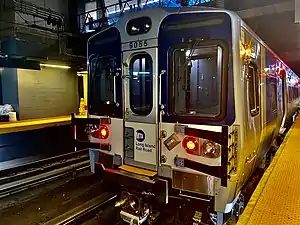 LIRR M9 #9055 at Penn Station after a run on the Far Rockaway Branch | |
| In service | 2019-present[1] |
| Manufacturer | Kawasaki Heavy Industries |
| Family name | M-series |
| Replaced | All remaining M3s |
| Entered service | M9: September 11, 2019 |
| Number under construction | 108 (option order);[2]:31 additional options for up to 318 more[3] |
| Number built | 94[2]:31 |
| Formation | married pairs |
| Fleet numbers | LIRR: 9001-9202[3] |
| Capacity | Seated passengers: 111 (A car); 101 (B car) |
| Operator(s) | MTA (Long Island Rail Road) |
| Specifications | |
| Car length | 85 ft (26 m) |
| Width | 10 ft 8 in (3.25 m) |
| Floor height | 48 Inches |
| Maximum speed | 100 mph (160 km/h) design 80 mph (130 km/h) service |
| Transmission | Mitsubishi Electric AC Traction Motors & IGBT inverters[4] |
| Power supply | TBD |
| Electric system(s) | 750 V DC Third rail |
| Current collection method | Contact shoe |
| Braking system(s) | Pneumatic, dynamic/regenerative |
| Coupling system | Budd Pin and Cup coupler |
| Track gauge | 4 ft 8 1⁄2 in (1,435 mm) standard gauge |
History
Contract timeline
In mid-2012, the MTA issued a joint procurement request for the LIRR and Metro-North for a total of up to 676 M9 railcars, set for delivery between 2016 and 2020.[8] On September 18, 2013, Kawasaki Heavy Industries was awarded a nearly $1.8 billion contract for the order, comprising a base order of 92 cars for the LIRR (costing $355 million) with options for an additional 584 cars (304 for the LIRR and 280 for MNR). Funding for the 92-car base order was included in the MTA's 2010-2014 Capital Plan, with funding for the rest of the order included in the 2015-2019 and future capital plans.[5][8] In July 2014, the MTA forecast a need of 416 M9 and M9A cars for the LIRR (180 cars to replace the M3 fleet and 236 cars for East Side Access-related increases) and up to 188 M9 cars for Metro-North, for a total order of 604 cars.[9] Of the 416 cars ordered for the LIRR, 160 would be M9A cars, a separate order to be paid for with federal funding from the Federal Transit Administration under the East Side Access project.[6] The MTA issued a request for proposals for 60-160 M9A cars in December 2017.[7]
In June 2018, Metro-North announced that they would elect to not exercise their options for the M9 order, instead overhauling their M3A units to extend their lifespan.[10] However, that November, Metro-North stated that they "are working with LIRR to procure new M9A cars in the next Capital Program to provide additional capacity and to replace their existing M3s instead of overhauling same."[11]
By October 2017, car production was delayed again as the 92-car base order was now scheduled for delivery between July 2018 and March 2019, at a cost of $393 million.[12] Construction delays in the East Side Access project meant that delivery of M9 and M9A railcars intended for use on that line had been deferred. An M9 trainset was delivered to Pueblo for testing in 2017, but LIRR field tests had been pushed back to April 2018.[7]
By June 2016, the M9 cars that were ordered for the LIRR were expected to be delivered starting in November 2018.[13]
Delivery schedule
The 416 cars of the LIRR's M9/M9A order is split into four parts. In July 2014, the delivery schedule was as follows: 92 base order cars (to be completed by April 2018) and 88 option 1 cars (to be completed by November 2018) to replace the M3 fleet as well as 76 option order cars (to be completed by August 2020) and 160 M9A cars (to be completed by October 2021) to be used for East Side Access service increases. 14 pilot cars were to be delivered September 2016 for testing, with the production cars being delivered at a rate of 12 cars per month. The balance of 188 cars for Metro-North was expected to begin delivery in December 2018 and be completed February 2020.[9][13]
By October 2016, the MTA forecast ordering 140-170 cars for Metro-North, which would bring the total size of the M9/M9A order to a maximum of 586 cars.[6] The production of the base order had suffered delays, and the first eight-car pilot train was now scheduled for testing at the Transportation Technology Center, Inc. (TTCI) facility in Pueblo, Colorado from June to August 2017, with the first fourteen-car pilot train on the LIRR was scheduled for testing from October to December 2017. The 92-car base order was now scheduled for delivery between June 2018 and January 2019. The first four M9s were delivered from the TTCI facility to the LIRR in mid-2018.[14][15]
The M9s began testing on June 12, 2018 and were expected to go into service by the end of May 2019. However, a variety of issues or bugs were found on the cars, delaying debut for additional weeks, until all of these issues or bugs have been resolved or ironed-out.[16] The cars in the original base order are expected to be completed in January 2020.[17][18]
The first set of 8-car M9 entered service on September 11, 2019, on the Port Jefferson Branch. The trainset (consisting of cars 9015, 9016, 9007, 9008, 9005, 9006, 9001 and 9002) originated from Huntington station at 6:50 AM and arrived at Hunterspoint Avenue station on time.[2]:31[19] As of January 2021, there were 68 cars in revenue service.[2]:31 The timeline for delivery of the base and option orders had been pushed back to October 2022. The original timeline had been delayed by 13 months due to defects found in on-site testing, as well as the onset of the COVID-19 pandemic in 2020.[2]:37
Features
The M9s are equipped with numerous customer amenity improvements over their predecessors. The cars are equipped with closed loop seat armrests similar to those on the M8s, wider seats, electrical outlets on both sides of a car in each row of seats, four 32-inch multimedia screens in each car, four to six additional seats per married pair, as well as powered doors on the "B" end of each car. The flip seats in the cars are equipped with a suspension system to prevent them from slamming. The cars also feature exterior destination signs that are visible on each end as the train approaches a station, to let passengers know where the train is going. All M9s will be equipped with positive train control (PTC) and CCTV cameras that allow the train crew to view the passenger areas of the train. Like the M7s and M8s, the M9s feature automated announcements and LED displays that show the current station, the following station, and the train's destination, external public address speakers, and electronic destination signs. Additionally, the internal and external destination signs also display the car's position within a train (for example: "Car 1 of 8"), allowing passengers to know where they are in case of stations with shorter platforms.[6] The M9 and M9A fleets incorporate new announcements that are easier to hear and understand, and differ from the M7/M7A, M8, and C3 fleets. The M9As also feature USB ports installed in each alternating current electrical outlet, as well as powered bathroom doors, stainless steel urinals in each bathroom, and Gorilla Glass side windows that do not haze, fade or crystallize.[6]
Gallery
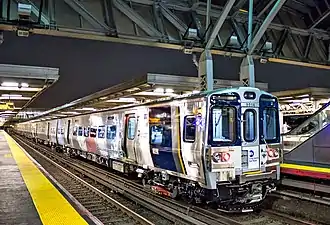 M9 train at Jamaica station
M9 train at Jamaica station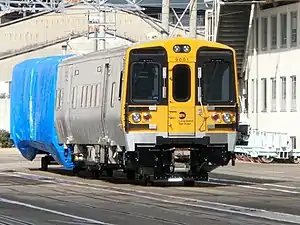 An M9 with the original yellow color scheme, now repainted into the standard blue and gold scheme
An M9 with the original yellow color scheme, now repainted into the standard blue and gold scheme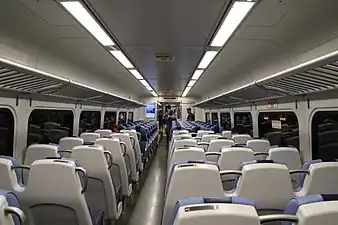 The interior of an M9 car
The interior of an M9 car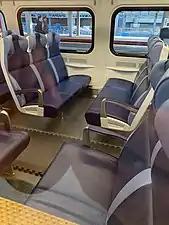 Seats and outlets in M9 cars
Seats and outlets in M9 cars
See also
References
- Stannard, Ed (March 1, 2011). "New Metro-North M8 rail cars take first run to New York". New Haven Register. Archived from the original on September 13, 2012. Retrieved March 1, 2011.
- "Capital Program Oversight Committee Meeting January 2021". web.mta.info. Metropolitan Transportation Authority. January 2021. Retrieved January 19, 2021.
- https://www.amodernli.com/project/new-m9-rail-cars/
- Kikuchi, Takahiro (December 4, 2014). "Transportation Systems" (PDF). Mitsubishi Electric.
- "Governor Cuomo Announces $1.8 Billion Award To Build 676 New LIRR and Metro-North Rail Cars". Governor Andrew M. Cuomo. September 28, 2014. Retrieved January 25, 2018.
- "Capital Program Oversight Committee Meeting October 2016" (PDF). mta.info. Metropolitan Transportation Authority. October 26, 2016. Retrieved November 17, 2016.
- "LIRR seeks M9A EMUs". Railway Age. December 6, 2017. Retrieved January 21, 2018.
- Bowen, Douglas John (September 17, 2013). "MTA taps Kawasaki for M-9 railcar order". Railway Age. Retrieved January 25, 2018.
- "Capital Program Oversight Committee Meeting: July 2014" (PDF). MTA. July 28, 2014.
- "Metro-North/LIRR Committee Meeting: June 2018". MTA. June 18, 2018.
- "Metro-North Railroad Committee Meeting" (PDF). Metropolitan Transportation Authority. November 13, 2018. p. 85. Archived from the original (PDF) on November 11, 2018. Retrieved December 1, 2018.
- "Capital Program Oversight Committee Meeting: October 2017" (PDF). MTA. October 23, 2017.
- "LIRR train delivery pushed back again". Newsday. June 20, 2016. Retrieved January 5, 2018.
- "Video shows new LIRR cars arriving". Newsday. July 12, 2018. Retrieved January 2, 2019.
- "First LIRR M-9 cars arrive from TTCI testing". Railway Age. May 16, 2018. Retrieved April 14, 2019.
- https://www.newsday.com/long-island/transportation/new-trains-delayed-m9-lirr-1.31387548
- "LIRR: Not enough train cars to serve booming ridership". News 12 Long Island. March 10, 2019. Retrieved April 14, 2019.
- "LIRR to roll out by end of May 'next generation of commuter rail cars". Newsday. May 7, 2019. Retrieved May 7, 2019.
- "Press Release - LIRR - LIRR to Introduce New Fleet of Rail Cars Tomorrow". MTA. September 10, 2019. Retrieved September 11, 2019.